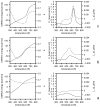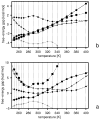Modification and optimization of the united-residue (UNRES) potential energy function for canonical simulations. I. Temperature dependence of the effective energy function and tests of the optimization method with single training proteins
- PMID: 17201450
- PMCID: PMC3236617
- DOI: 10.1021/jp065380a
Modification and optimization of the united-residue (UNRES) potential energy function for canonical simulations. I. Temperature dependence of the effective energy function and tests of the optimization method with single training proteins
Abstract
We report the modification and parametrization of the united-residue (UNRES) force field for energy-based protein structure prediction and protein folding simulations. We tested the approach on three training proteins separately: 1E0L (beta), 1GAB (alpha), and 1E0G (alpha + beta). Heretofore, the UNRES force field had been designed and parametrized to locate native-like structures of proteins as global minima of their effective potential energy surfaces, which largely neglected the conformational entropy because decoys composed of only lowest-energy conformations were used to optimize the force field. Recently, we developed a mesoscopic dynamics procedure for UNRES and applied it with success to simulate protein folding pathways. However, the force field turned out to be largely biased toward -helical structures in canonical simulations because the conformational entropy had been neglected in the parametrization. We applied the hierarchical optimization method, developed in our earlier work, to optimize the force field; in this method, the conformational space of a training protein is divided into levels, each corresponding to a certain degree of native-likeness. The levels are ordered according to increasing native-likeness; level 0 corresponds to structures with no native-like elements, and the highest level corresponds to the fully native-like structures. The aim of optimization is to achieve the order of the free energies of levels, decreasing as their native-likeness increases. The procedure is iterative, and decoys of the training protein(s) generated with the energy function parameters of the preceding iteration are used to optimize the force field in a current iteration. We applied the multiplexing replica-exchange molecular dynamics (MREMD) method, recently implemented in UNRES, to generate decoys; with this modification, conformational entropy is taken into account. Moreover, we optimized the free-energy gaps between levels at temperatures corresponding to a predominance of folded or unfolded structures, as well as to structures at the putative folding-transition temperature, changing the sign of the gaps at the transition temperature. This enabled us to obtain force fields characterized by a single peak in the heat capacity at the transition temperature. Furthermore, we introduced temperature dependence to the UNRES force field; this is consistent with the fact that it is a free-energy and not a potential energy function. beta
Figures

























Similar articles
-
Ab initio simulations of protein-folding pathways by molecular dynamics with the united-residue model of polypeptide chains.Proc Natl Acad Sci U S A. 2005 Feb 15;102(7):2362-7. doi: 10.1073/pnas.0408885102. Epub 2005 Jan 26. Proc Natl Acad Sci U S A. 2005. PMID: 15677316 Free PMC article.
-
Molecular dynamics with the united-residue model of polypeptide chains. II. Langevin and Berendsen-bath dynamics and tests on model alpha-helical systems.J Phys Chem B. 2005 Jul 21;109(28):13798-810. doi: 10.1021/jp058007w. J Phys Chem B. 2005. PMID: 16852728 Free PMC article.
-
A Maximum-Likelihood Approach to Force-Field Calibration.J Chem Inf Model. 2015 Sep 28;55(9):2050-70. doi: 10.1021/acs.jcim.5b00395. Epub 2015 Aug 20. J Chem Inf Model. 2015. PMID: 26263302
-
Coarse-grained force field: general folding theory.Phys Chem Chem Phys. 2011 Oct 14;13(38):16890-901. doi: 10.1039/c1cp20752k. Epub 2011 Jun 3. Phys Chem Chem Phys. 2011. PMID: 21643583 Free PMC article. Review.
-
My 65 years in protein chemistry.Q Rev Biophys. 2015 May;48(2):117-77. doi: 10.1017/S0033583514000134. Epub 2015 Apr 8. Q Rev Biophys. 2015. PMID: 25850343 Free PMC article. Review.
Cited by
-
Ab initio protein structure assembly using continuous structure fragments and optimized knowledge-based force field.Proteins. 2012 Jul;80(7):1715-35. doi: 10.1002/prot.24065. Epub 2012 Apr 13. Proteins. 2012. PMID: 22411565 Free PMC article.
-
How main-chains of proteins explore the free-energy landscape in native states.Proc Natl Acad Sci U S A. 2008 Dec 16;105(50):19708-13. doi: 10.1073/pnas.0810679105. Epub 2008 Dec 10. Proc Natl Acad Sci U S A. 2008. PMID: 19073932 Free PMC article.
-
Extension of UNRES force field to treat polypeptide chains with D-amino-acid residues.J Chem Theory Comput. 2012 Nov 13;8(11):4746-4757. doi: 10.1021/ct3005563. J Chem Theory Comput. 2012. PMID: 24729761 Free PMC article.
-
Extension of coarse-grained UNRES force field to treat carbon nanotubes.J Mol Model. 2018 Apr 26;24(5):121. doi: 10.1007/s00894-018-3656-1. J Mol Model. 2018. PMID: 29700628 Free PMC article.
-
Role of Glycosaminoglycans in Procathepsin B Maturation: Molecular Mechanism Elucidated by a Computational Study.J Chem Inf Model. 2020 Apr 27;60(4):2247-2256. doi: 10.1021/acs.jcim.0c00023. Epub 2020 Apr 1. J Chem Inf Model. 2020. PMID: 32155059 Free PMC article.
References
-
- Skolnick J, Zhang Y, Arakaki AK, Kolińsi A, Boniecki M, Szilagyi A, Kihara D. Proteins: Struct Func Genet. 2003;53:469. - PubMed
-
- Eskow E, Bader D, Byrd R, Crivelli S, Head-Gordon T, Lamberti V, Schnabel R. Math Program. 2004;101:497.
-
- Fujitsuka Y, Takada S, Luthey-Schulten ZA, Wolynes PG. Proteins: Struct Func Genet. 2004;54:88. - PubMed
-
- Scheraga HA, Liwo A, Ołdziej S, Czaplewski C, Pillardy J, Ripoll DR, Vila JA, KaŸmierkiewicz R, Saunders JA, Arnautova YA, Jagielska A, Chinchio M, Nanias M. Frontiers in Bioscience. 2004;9:3296. - PubMed
-
- Petrey D, Honig B. Mol Cell. 2005;20:811. - PubMed
Publication types
MeSH terms
Substances
Grants and funding
LinkOut - more resources
Full Text Sources

